A Comparative Investigation of CFD Approaches for Oil–Air Two-Phase Flow in High-Speed Lubricated Rolling Bearings
Abstract
1. Introduction
1.1. Related Works
1.2. Motivation and Contribution
1.3. Organization
2. Problem Formulation and Preliminary Experiments
2.1. Oil Injection Mechanism of Bearing
- Incompressible viscous lubricant: Incompressible viscous fluid: The lubricating oil is treated as an incompressible Newtonian fluid, meaning its density remains constant while accounting for viscous effects.
- Isothermal flow condition: The system maintains constant temperature, resulting in temperature-independent lubricant viscosity.
2.2. Experimental System
2.3. Preliminary Results
3. FVM Model
3.1. Numerical Method
3.1.1. Governing Equations
3.1.2. Turbulence Model
3.1.3. Multiphase Flow Model
- When : The control volume is entirely filled with the i-th phase fluid.
- When : The i-th phase fluid is completely absent from the control volume.
- When : The control volume contains a mixture of the i-th phase with other phases.
3.2. Meshing and Boundary Conditions
3.3. Result of FVM
4. MPS Model
4.1. Numerical Method
4.1.1. Governing Equations
4.1.2. Kernel Function and Particle Density
4.1.3. Particle Action Model
4.2. Result of MPS
5. Experimental Verification of FVM Model and MPS Model
6. Discussion
6.1. Adaptability to Speed Conditions
6.2. Research Focus
6.3. Economic Considerations
7. Conclusions
- For medium-to-high speed conditions, FVM demonstrates superior suitability for conventional industrial design applications. Conversely, MPS provides more physically accurate representations of complex scenarios involving low speeds or large deformations, though its computational resource demands increase substantially with higher rotational speeds.
- In quantitative analysis of continuous oil films and power loss, FVM exhibits greater reliability. MPS, while excelling in capturing dynamic behaviors of discontinuous flows, typically requires trade-offs in quantitative precision.
- Leveraging its mature software ecosystem and computational efficiency for routine analyses, FVM proves more appropriate for industrial applications. MPS shows significant potential for customized research, particularly in simplified modeling of extreme operating conditions, making it better suited for scientific investigations despite its higher resource requirements.
Author Contributions
Funding
Data Availability Statement
Conflicts of Interest
Abbreviations
| CFD | Computational Fluid Dynamics |
| FVM | Finite Volume Method |
| MPS | Moving Particle Semi-implicit Method |
| LIF | Laser-induced Fluorescence |
| EHL | Elastohydrodynamic Lubrication |
| TEHL | Thermal Elastohydrodynamic Lubrication |
| DOF | Degree of Freedom |
References
- Damiens, B.; Lubrecht, A.A.; Cann, P.M. Influence of Cage Clearance on Bearing Lubrication©. Tribol. Trans. 2004, 47, 2–6. [Google Scholar] [CrossRef]
- Liang, H.; Guo, D.; Luo, J. Experimental Investigation of Lubrication Film Starvation of Polyalphaolefin Oil at High Speeds. Tribol. Lett. 2014, 56, 491–500. [Google Scholar] [CrossRef]
- Liang, H.; Guo, D.; Ma, L.; Luo, J. Experimental Investigation of Centrifugal Effects on Lubricant Replenishment in the Starved Regime at High Speeds. Tribol. Lett. 2015, 59, 3. [Google Scholar] [CrossRef]
- Liang, H.; Zhang, Y.; Wang, W. Influence of the cage on the migration and distribution of lubricating oil inside a ball bearing. Friction 2022, 10, 1035–1045. [Google Scholar] [CrossRef]
- Chen, H.; Wang, W.; Liang, H.; Ge, X. Observation of the oil flow in a ball bearing with a novel experiment method and simulation. Tribol. Int. 2022, 174, 107731. [Google Scholar] [CrossRef]
- Peterson, W.; Sadeghi, F.; Meinel, A.; Grillenberger, H. Investigation of Roller Bearing Cage Pocket Lubrication and Friction. J. Tribol. 2023, 145, 054302. [Google Scholar] [CrossRef]
- de Cadier de Veauce, F.; Marchesse, Y.; Touret, T.; Changenet, C.; Ville, F.; Amar, L.; Fossier, C. Power Losses of Oil-Bath-Lubricated Ball Bearings—A Focus on Churning Losses. Lubricants 2024, 12, 362. [Google Scholar] [CrossRef]
- Osborne, R., IV. On the theory of lubrication and its application to Mr. Beauchamp tower’s experiments, including an experimental determination of the viscosity of olive oil. Philos. Trans. R. Soc. Lond. 1886, 177, 157–234. [Google Scholar] [CrossRef]
- Tian, J.; Zhang, C.; Liang, H.; Guo, D. Simulation of the load reduction process of high-speed angular contact ball bearing with coupling model of dynamics and thermo-elastohydrodynamic lubrication. Tribol. Int. 2022, 165, 107292. [Google Scholar] [CrossRef]
- Wen, C.; Meng, X.; Gu, J.; Xiao, L.; Jiang, S.; Bi, H. Starved lubrication analysis of angular contact ball bearing based on a multi-degree-of-freedom tribo-dynamic model. Friction 2023, 11, 1395–1418. [Google Scholar] [CrossRef]
- Zhao, Y.; Zi, Y.; Chen, Z.; Zhang, M.; Zhu, Y.; Yin, J. Power loss investigation of ball bearings considering rolling-sliding contacts. Int. J. Mech. Sci. 2023, 250, 108318. [Google Scholar] [CrossRef]
- Hu, J.; Wu, W.; Wu, M.; Yuan, S. Numerical investigation of the air–oil two-phase flow inside an oil-jet lubricated ball bearing. Int. J. Heat Mass Transf. 2014, 68, 85–93. [Google Scholar] [CrossRef]
- Wu, W.; Hu, J.; Yuan, S.; Hu, C. Numerical and experimental investigation of the stratified air-oil flow inside ball bearings. Int. J. Heat Mass Transf. 2016, 103, 619–626. [Google Scholar] [CrossRef]
- Yan, K.; Wang, Y.; Zhu, Y.; Hong, J.; Zhai, Q. Investigation on heat dissipation characteristic of ball bearing cage and inside cavity at ultra high rotation speed. Tribol. Int. 2016, 93, 470–481. [Google Scholar] [CrossRef]
- Deng, S.; Zhao, G.; Qian, D.; Jiang, S.; Hua, L. Investigation of Oil–Air Flow and Temperature for High-Speed Ball Bearings by Combining Nonlinear Dynamic and Computational Fluid Dynamics Models. J. Tribol. 2022, 144, 071204. [Google Scholar] [CrossRef]
- Liu, J.; Ni, H.; Zhou, R.; Li, X.; Xing, Q.; Pan, G. A Simulation Analysis of Ball Bearing Lubrication Characteristics Considering the Cage Clearance. J. Tribol. 2022, 145, 044301. [Google Scholar] [CrossRef]
- Gao, W.; Nelias, D.; Boisson, N.; Lyu, Y. Model formulation of churning losses in cylindrical roller bearings based on numerical simulation. Tribol. Int. 2018, 121, 420–434. [Google Scholar] [CrossRef]
- Gao, W.; Lyu, Y.; Liu, Z.; Nelias, D. Validation and application of a numerical approach for the estimation of drag and churning losses in high speed roller bearings. Appl. Therm. Eng. 2019, 153, 390–397. [Google Scholar] [CrossRef]
- Hu, S.; Gong, W.; Xu, X.; Liu, X. Modeling of ball bearing churning losses. Phys. Fluids 2024, 36, 083305. [Google Scholar] [CrossRef]
- Wu, W.; Wei, C.; Yuan, S. Numerical simulation of ball bearing flow field using the moving particle semi-implicit method. Eng. Appl. Comput. Fluid Mech. 2022, 16, 215–228. [Google Scholar] [CrossRef]
- Wei, C.; Wu, W.; Hou, X.; Yuan, S. Study on Oil Distribution and Oil Content of Oil Bath Lubrication Bearings Based on MPS Method. Tribol. Trans. 2022, 65, 942–951. [Google Scholar] [CrossRef]
- Chen, S.W.; Matsumoto, S. Influence of Relative Position of Gears and Casing Wall Shape of Gear Box on Churning Loss under Splash Lubrication Condition—Some New Ideas. Tribol. Trans. 2016, 59, 993–1004. [Google Scholar] [CrossRef]
- Gao, J.; Yang, P.; Li, X.; Gao, Z.; Guo, F.; Gerhard, P. Numerical Simulation of Oil Layer Decay on Bearing Raceway under Centrifugal Force and Quantitative Lubricant Replenishment. Tribology 2024, 44, 1184–1191. [Google Scholar] [CrossRef]
- Ma, Y.; Xiao, X.; Li, W.; Desbrun, M.; Liu, X. Hybrid LBM-FVM solver for two-phase flow simulation. J. Comput. Phys. 2024, 506, 112920. [Google Scholar] [CrossRef]
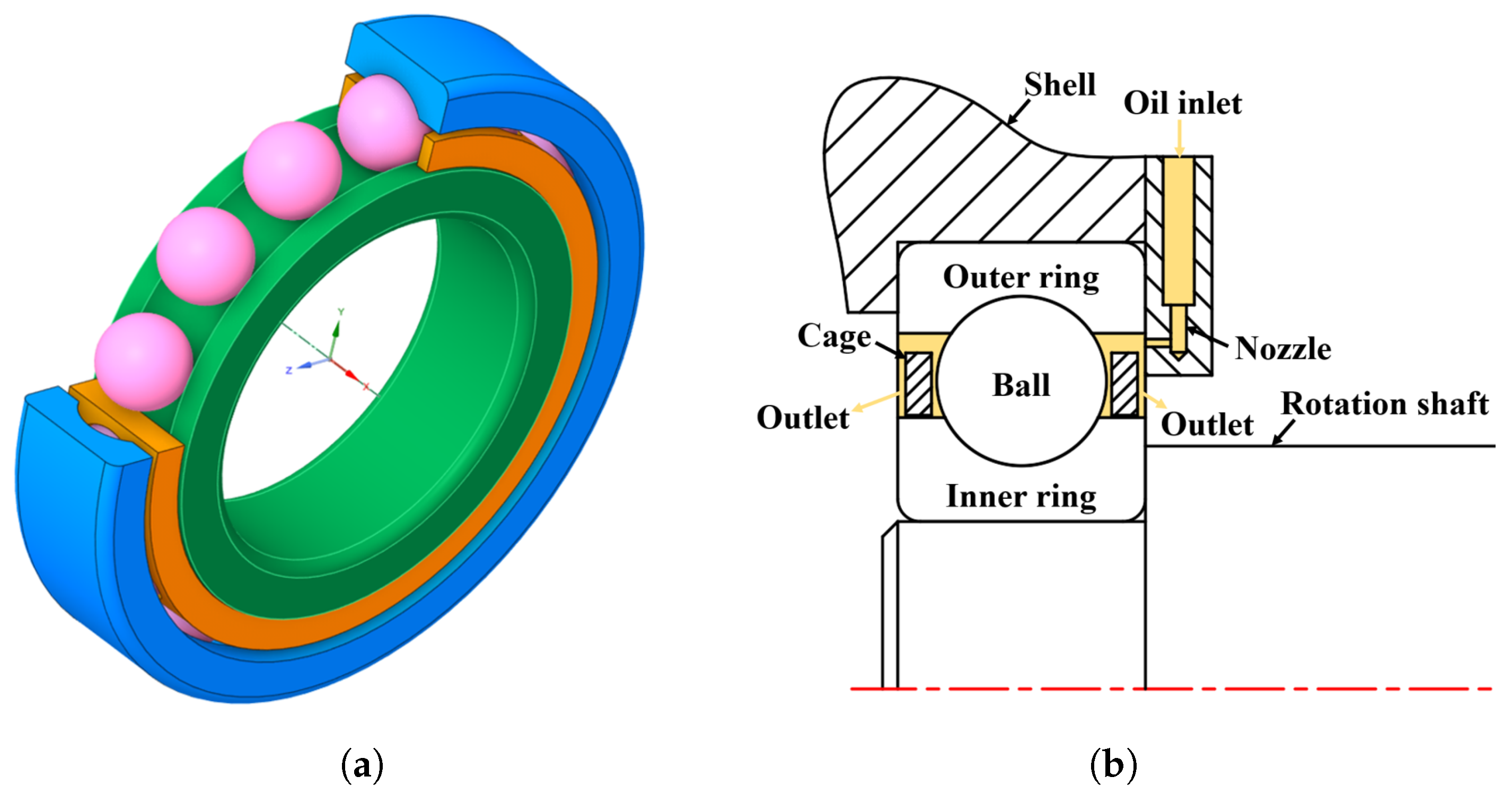
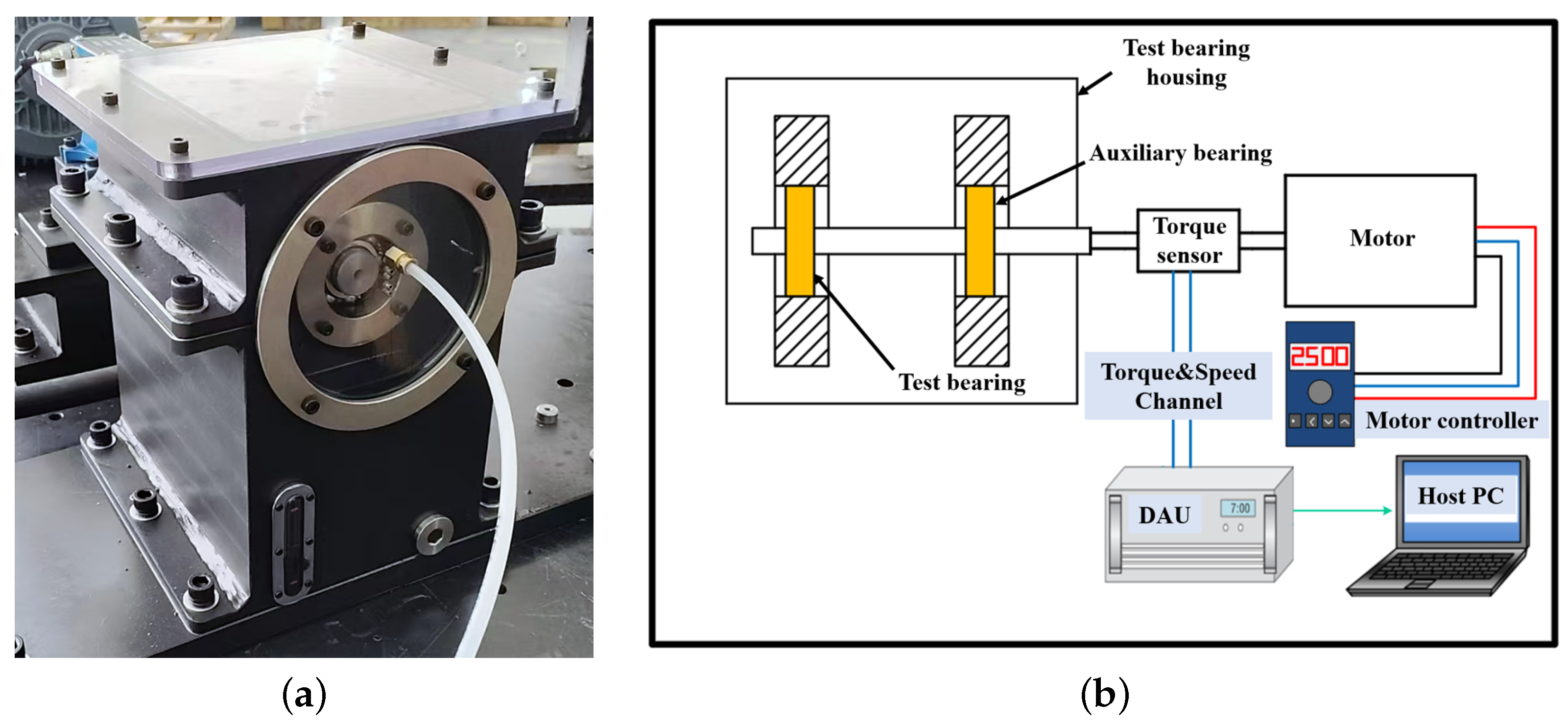
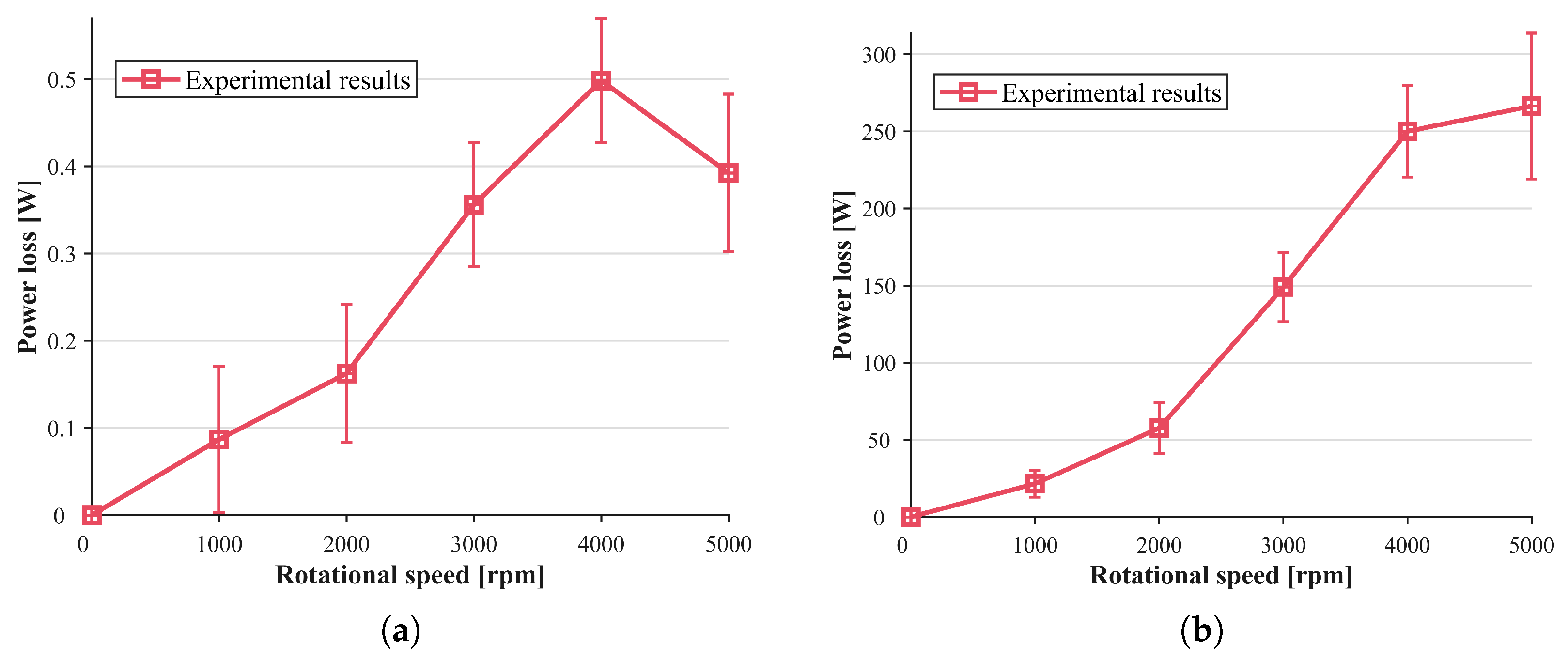
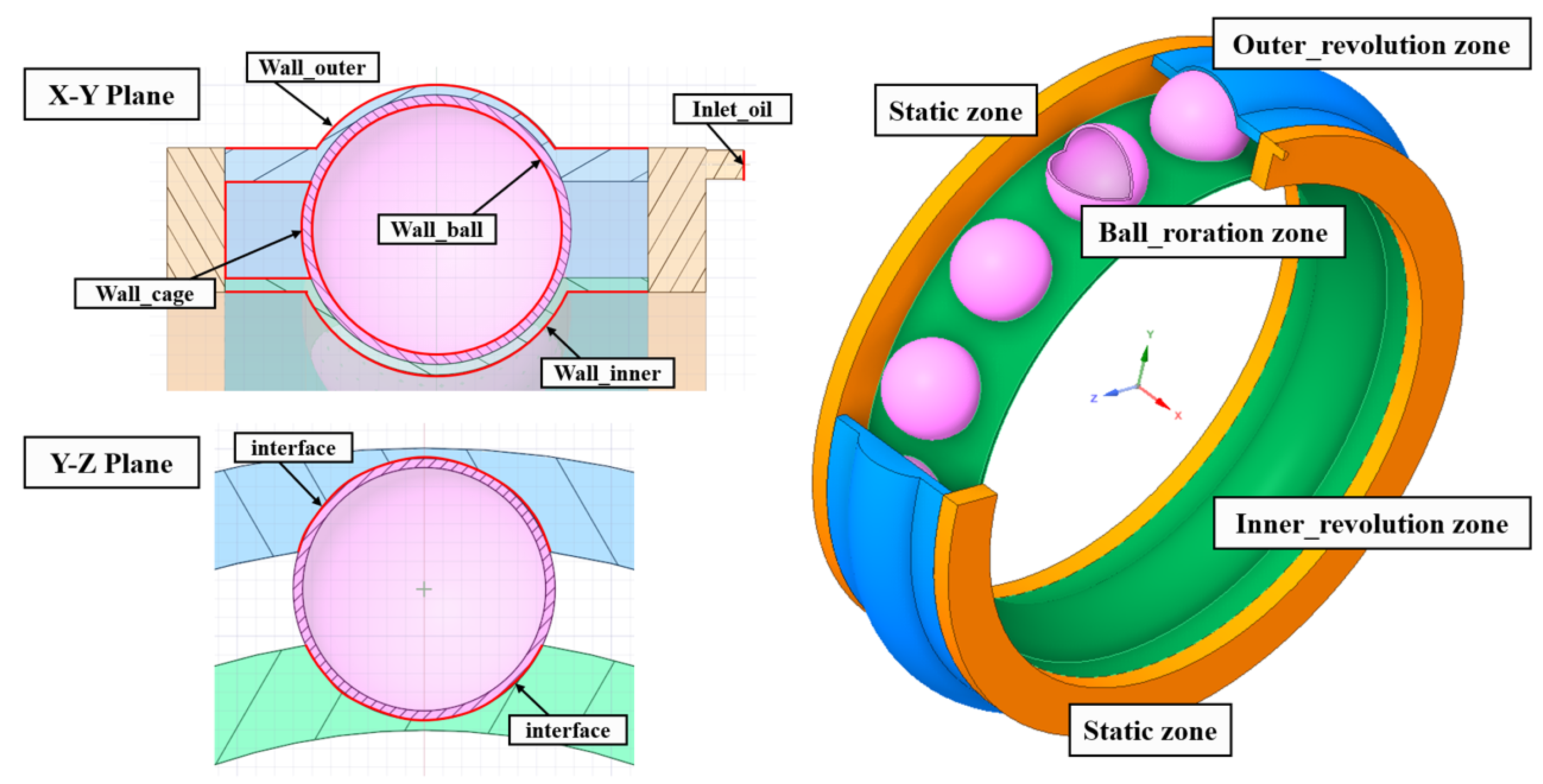
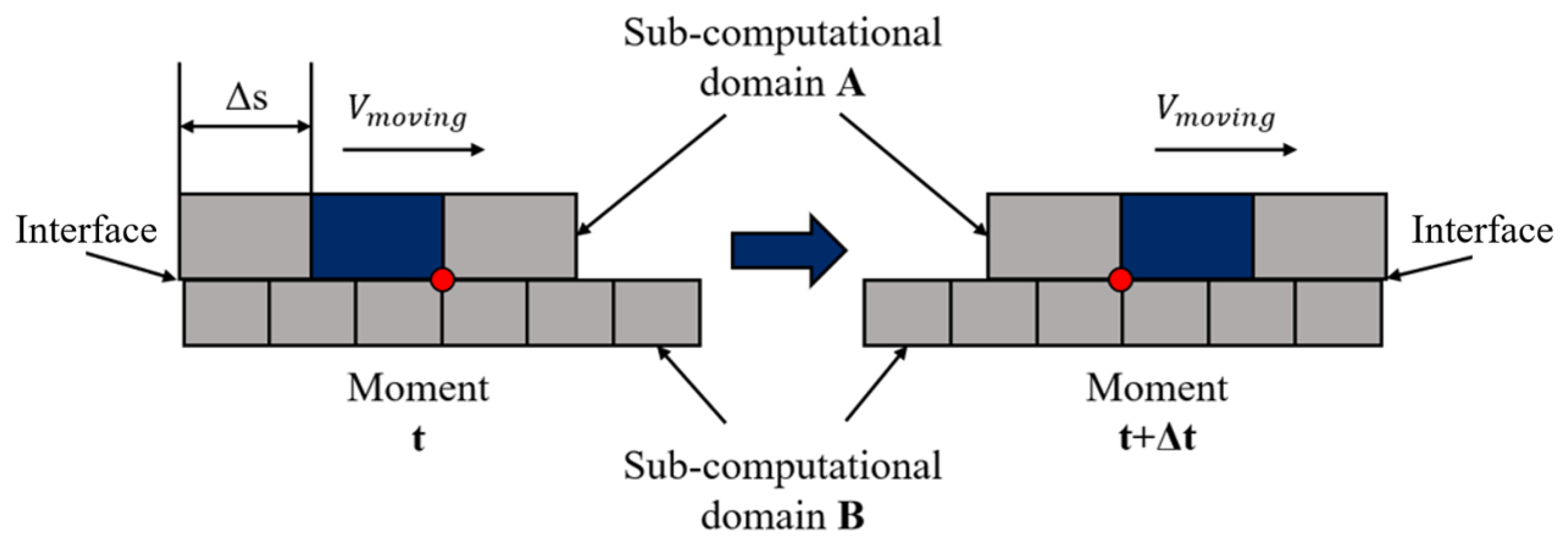
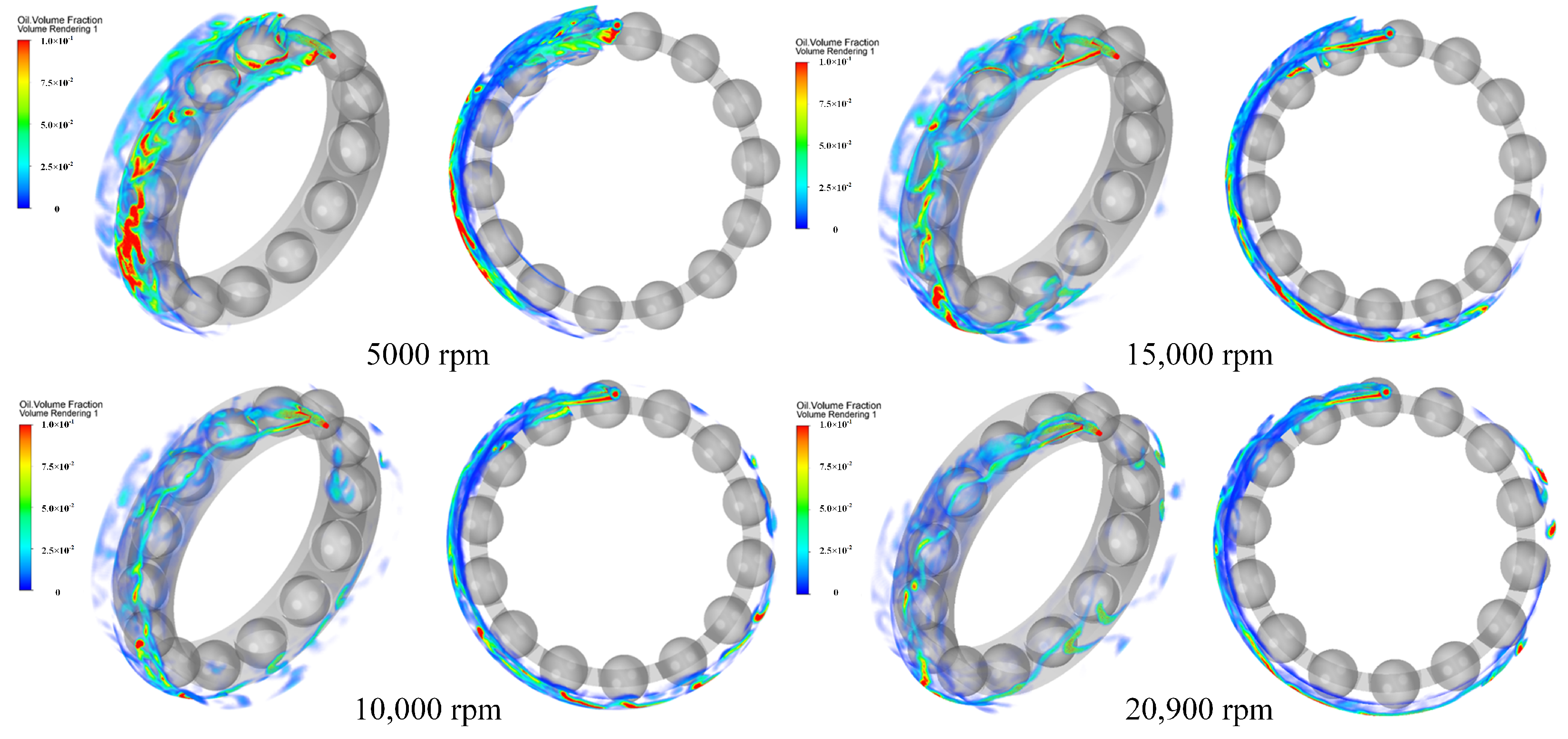

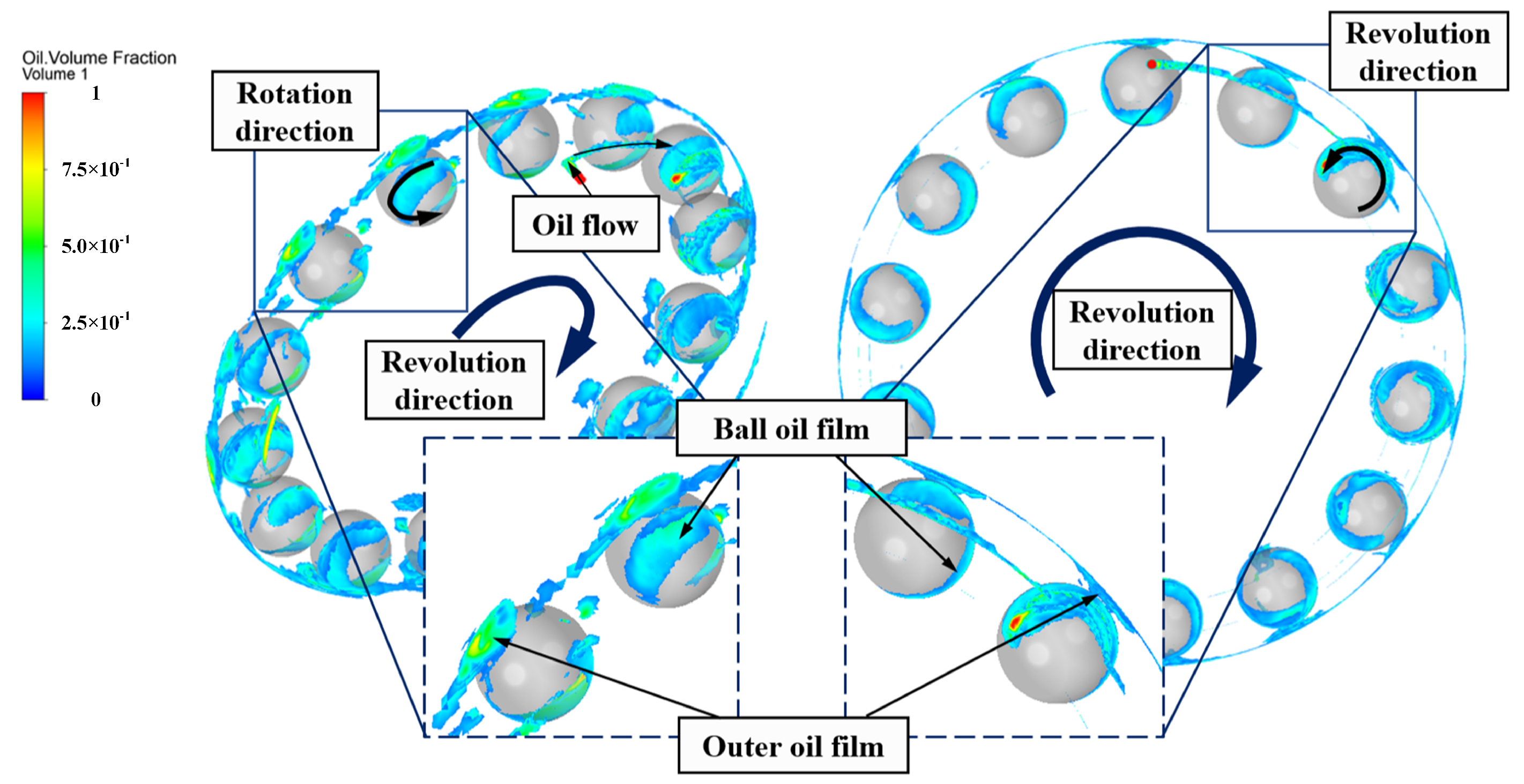


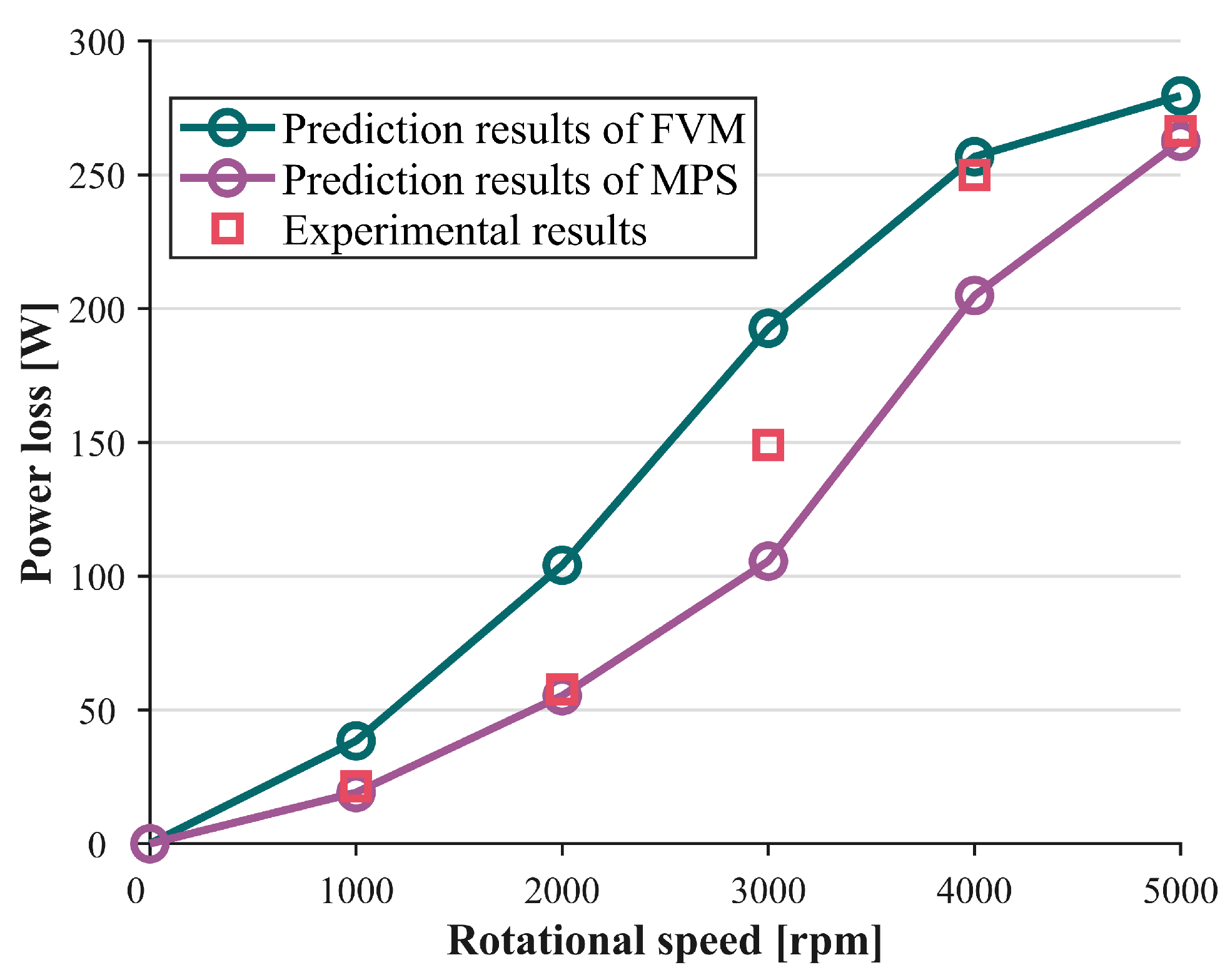

| Denotation | Symbol | Value |
|---|---|---|
| Inner diameter (mm) | d | 60 |
| Outer diameter (mm) | D | 110 |
| Width (mm) | B | 22 |
| Ball diameter (mm) | 4 | |
| Number of balls | Z | 14 |
| Nozzle diameter (mm) |
| Denotation | Symbol | Value |
|---|---|---|
| Density () | 920 | |
| Dynamic viscosity (Pa· s) | ||
| Oil temperature () | T | 60 |
| Denotation | Symbol | Value |
|---|---|---|
| Inner diameter (mm) | d | 30 |
| Outer diameter (mm) | D | 62 |
| Width (mm) | B | 16 |
| Ball diameter (mm) | ||
| Number of balls | Z | 9 |
| Nozzle diameter (mm) |
| Denotation | Symbol | Value |
|---|---|---|
| Density () | 853 | |
| Dynamic viscosity (Pa· s) | ||
| Oil temperature () | T | 20 |
| Model | Time Consumption (h) |
|---|---|
| FVM | 11 |
| MPS | 14–18 |
Disclaimer/Publisher’s Note: The statements, opinions and data contained in all publications are solely those of the individual author(s) and contributor(s) and not of MDPI and/or the editor(s). MDPI and/or the editor(s) disclaim responsibility for any injury to people or property resulting from any ideas, methods, instructions or products referred to in the content. |
© 2025 by the authors. Licensee MDPI, Basel, Switzerland. This article is an open access article distributed under the terms and conditions of the Creative Commons Attribution (CC BY) license (https://creativecommons.org/licenses/by/4.0/).
Share and Cite
Zhao, R.; Zhou, P.; Zhong, J.; Yang, D.; Ling, J. A Comparative Investigation of CFD Approaches for Oil–Air Two-Phase Flow in High-Speed Lubricated Rolling Bearings. Machines 2025, 13, 678. https://doi.org/10.3390/machines13080678
Zhao R, Zhou P, Zhong J, Yang D, Ling J. A Comparative Investigation of CFD Approaches for Oil–Air Two-Phase Flow in High-Speed Lubricated Rolling Bearings. Machines. 2025; 13(8):678. https://doi.org/10.3390/machines13080678
Chicago/Turabian StyleZhao, Ruifeng, Pengfei Zhou, Jianfeng Zhong, Duan Yang, and Jie Ling. 2025. "A Comparative Investigation of CFD Approaches for Oil–Air Two-Phase Flow in High-Speed Lubricated Rolling Bearings" Machines 13, no. 8: 678. https://doi.org/10.3390/machines13080678
APA StyleZhao, R., Zhou, P., Zhong, J., Yang, D., & Ling, J. (2025). A Comparative Investigation of CFD Approaches for Oil–Air Two-Phase Flow in High-Speed Lubricated Rolling Bearings. Machines, 13(8), 678. https://doi.org/10.3390/machines13080678






